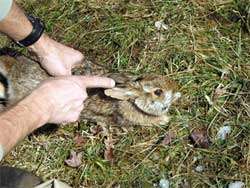New England cottontail on verge of disappearing from Rhode Island

Rhode Island’s native rabbit, the New England cottontail, is on the verge of being extirpated from the state after a survey of appropriate habitat and historical breeding sites by more than 100 University of Rhode Island students and staff from the R.I. Department of Environmental Management found evidence of just one animal.
According to URI Professor Thomas Husband and DEM Wildlife Biologist Brian Tefft, who have been studying the rabbits for nearly 20 years, the New England cottontail has been supplanted in the region by the abundant eastern cottontail, of which more than 200,000 were introduced to New England in the early 1900s for hunters.
In 2005, the last time biologists searched for the animal, Tefft found the cottontail in only a few locations. None were found at those sites during this year’s survey.
“The animals have been declining throughout New England for a number of years, but nobody knows for certain why,” said Husband, adding that the species has nearly disappeared from New Hampshire as well, and very few populations remain in Massachusetts, Connecticut, Maine and New York.
The researchers say that habitat loss and predation may be among the causes of the New England cottontail’s decline, though the eastern cottontail uses very similar early successional habitats and must deal with the same predators.
“It’s also possible that subtle differences in their morphology could contribute to their decline,” Husband said.
New England cottontails have smaller eyes placed farther forward on their head than their eastern cousin, which may give them a lesser ability to see predators in their peripheral vision, suggesting that they may not be as willing to use open habitat as the eastern cottontail. The eastern cottontail also tends to run away from approaching predators sooner than the New England cottontail.
“But it’s all speculation as to whether or not that’s a factor,” Husband added.
The two species of cottontail are virtually identical. The researchers say that the best way to distinguish the two is to examine their skulls or to compare DNA.
To survey for the New England cottontail, the scientists sent more than 100 URI students and DEM staff members to random locations in appropriate habitat and known historical breeding sites to collect rabbit droppings for DNA analysis. Of the nearly 1,000 samples collected from more than 100 locations, only one contained the DNA of the New England cottontail, according to T.J. McGreevy, a former URI postdoctoral researcher who supervised the analysis conducted by URI graduate student Mary Niebels.
Husband said that another survey for the native rabbit will be conducted next year to confirm the results. He and Tefft and a regional team of biologists are already strategizing about how to reintroduce the species. A URI graduate student, Amy Gottfried, is trying to identify the subtle differences in habitat preferences between the two species so the New England cottontail’s preferred habitat can be restored.
“We’ve got to look for refugia for these animals, a place where we can perhaps breed them before reintroducing them to the state,” Husband said.
He said that a habitat analysis is being conducted on Patience Island, in the middle of Rhode Island’s Narragansett Bay, to determine if the rabbits could be introduced there as a test site. The island has never had a population of either cottontail species in the past. Another URI graduate student, Cynthia Maynard, is doing a similar analysis of a small island near Martha’s Vineyard.
The New England cottontail is a high priority candidate for the federal endangered species list, and the U.S. Natural Resource Conservation Service is providing funding for habitat restoration projects in the region. DEM, through a U.S. Fish and Wildlife Service grant, provided funding to help establish the Wildlife Conservation Genetics Lab at URI, where the rabbits are being identified, and to conduct other cottontail research projects.
Husband said that some people have asked why there is a concern when one rabbit disappears and another nearly identical one takes its place.
“’If we’ve got little brown rabbits, then who cares which species it is,’ they ask me,” said the URI professor. “Well, on one hand, everything has a right to exist and even thrive, in spite of what humans think or do. But also, we probably caused this problem, by dumping 200,000 non-native rabbits here, so we should try to fix it. Predators have returned to the state in big numbers – fishers, bobcats, coyotes – and that may be in part because we have this abundant eastern cottontail for them to feed on. New England cottontails seem to be more vulnerable, and they’ve become collateral damage.
“New England cottontails may have a unique role in the environment,” he concluded. “We just don’t know yet what it is.”
Provided by University of Rhode Island



















